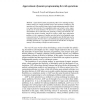114 search results - page 15 / 23 » Mind Change Complexity of Learning Logic Programs |
USS
2010
13 years 5 months ago
2010
Web applications are the most common way to make services and data available on the Internet. Unfortunately, with the increase in the number and complexity of these applications, ...
ICALT
2008
IEEE
14 years 2 months ago
2008
IEEE
Collaboration has long been considered an effective approach to learning. However, forming optimal groups can be a time consuming and complex task. Different approaches have been ...
ICLP
2009
Springer
14 years 8 months ago
2009
Springer
We address how to write programs for distributed computing systems in which the network topology can change dynamically. Examples of such systems, which we call ensembles, include ...
CEC
2010
IEEE
12 years 11 months ago
2010
IEEE
— If a population of programs evolved not for a few hundred generations but for a few hundred thousand or more, could it generate more interesting behaviours and tackle more comp...
ATMOS
2007
13 years 9 months ago
2007
Abstract. Approximate dynamic programming offers a new modeling and algorithmic strategy for complex problems such as rail operations. Problems in rail operations are often modeled...

